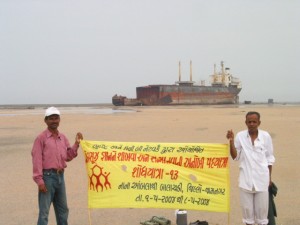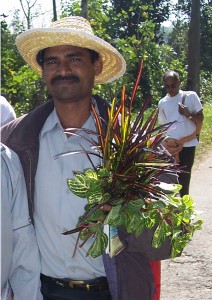 Why did you go to such interior places in Bastar? Don’t you know it is dangerous, asked the Police officer. Parshottam replied, “How else will we learn about the problems of the neglected communities?”. He was involved in designing a route plan for almost all the thirty five Shodhyatras in practically in every state of the country, except Arunachal Pradesh and Nagaland. There were days when he will only eat and take rest because of heavy rains. But there were many days when he would go without food the whole day. Most Shodhyatris have no Idea as to what it takes to prepare for one. Not just the route plan but also where would we eat, where would we sleep and where would meetings take place has to be planned. And on top of it, because of landslides, roadblocks, disturbances in certain villages or other inexplicable reasons, changes have to be made at the last minute. He would find local partners, including volunteers who would help in making contingency plans. During shodhyatra in Cherrapunji, Meghalaya we lost our way and reached our destination in the middle of the night. Such things happen several times. I remember in Purulia, we had a similar situation with police warning us of the extremists in the region. We had similar warnings in Arku valley, Andhra
Why did you go to such interior places in Bastar? Don’t you know it is dangerous, asked the Police officer. Parshottam replied, “How else will we learn about the problems of the neglected communities?”. He was involved in designing a route plan for almost all the thirty five Shodhyatras in practically in every state of the country, except Arunachal Pradesh and Nagaland. There were days when he will only eat and take rest because of heavy rains. But there were many days when he would go without food the whole day. Most Shodhyatris have no Idea as to what it takes to prepare for one. Not just the route plan but also where would we eat, where would we sleep and where would meetings take place has to be planned. And on top of it, because of landslides, roadblocks, disturbances in certain villages or other inexplicable reasons, changes have to be made at the last minute. He would find local partners, including volunteers who would help in making contingency plans. During shodhyatra in Cherrapunji, Meghalaya we lost our way and reached our destination in the middle of the night. Such things happen several times. I remember in Purulia, we had a similar situation with police warning us of the extremists in the region. We had similar warnings in Arku valley, Andhra  Pradesh; Anantnag, Jammu and Kashmir; Churachandrapur , Manipur; Narayanpur, Bastar; Dahlai, Tripura; etc. Not once, did we feel insecure, thanks to the community support mobilized by Parshottam and his team and other local partners. And even extremist empathizing perhaps with our mission.
Pradesh; Anantnag, Jammu and Kashmir; Churachandrapur , Manipur; Narayanpur, Bastar; Dahlai, Tripura; etc. Not once, did we feel insecure, thanks to the community support mobilized by Parshottam and his team and other local partners. And even extremist empathizing perhaps with our mission.
Frugality was deeply ingrained in his DNA. If he could manage something by using public bus, he would not take a private bus and if ordinary sleeper class was available, then he would not take third tier ac in train.
 So many community contests for competitions, ideas, and recipes were organized by him among hundreds of communities. He had walked almost three times the distance we walked because while preparing for Shodhyatras several alternatives had to be explored. He had a great sense of finding out if any shodhyatri was suffering inside. Invariably, he would quietly do the needful including asking some other yatris to look after the affected one. There were so many innovators who got The President Award through NIF because of being scouted by him such as Shakrabhai and Kapuriben. There were many who got SRISTI Samman, community workshop and other support through his advocacy or documentation.
So many community contests for competitions, ideas, and recipes were organized by him among hundreds of communities. He had walked almost three times the distance we walked because while preparing for Shodhyatras several alternatives had to be explored. He had a great sense of finding out if any shodhyatri was suffering inside. Invariably, he would quietly do the needful including asking some other yatris to look after the affected one. There were so many innovators who got The President Award through NIF because of being scouted by him such as Shakrabhai and Kapuriben. There were many who got SRISTI Samman, community workshop and other support through his advocacy or documentation.
 As a human being, he was a man of few words, always smiling and keeping a positive outlook. Never once, did he complain about anyone or any situation. He had to live away from his family for months. He succumbed to multi organ cancer detected very late. We were hopeful that some traditional medicine might work. Actually if only it was detected earlier there might have been a good chance of survival. But his strength and ability to bear occasional pain quietly became his biggest weakness. Early detection of cancer makes it curable. It is always good to get medical checkup done in time and if possible by being vigilant. That will not completely eliminate the situation that Parshottam faced but minimize it.
As a human being, he was a man of few words, always smiling and keeping a positive outlook. Never once, did he complain about anyone or any situation. He had to live away from his family for months. He succumbed to multi organ cancer detected very late. We were hopeful that some traditional medicine might work. Actually if only it was detected earlier there might have been a good chance of survival. But his strength and ability to bear occasional pain quietly became his biggest weakness. Early detection of cancer makes it curable. It is always good to get medical checkup done in time and if possible by being vigilant. That will not completely eliminate the situation that Parshottam faced but minimize it.
He was the longest serving colleague in SRISTI. The Honey Bee Network grew on his shoulders. Unfortunately, much of the credit I got in my life actually belonged to unsung heroes of the Network like Parshottam. I wish foundational stones like him get credit for all the moss that gets collected.
